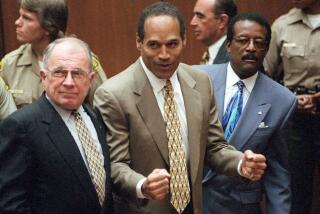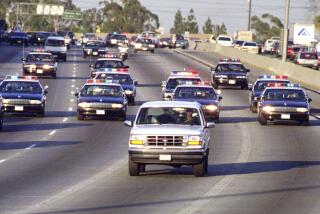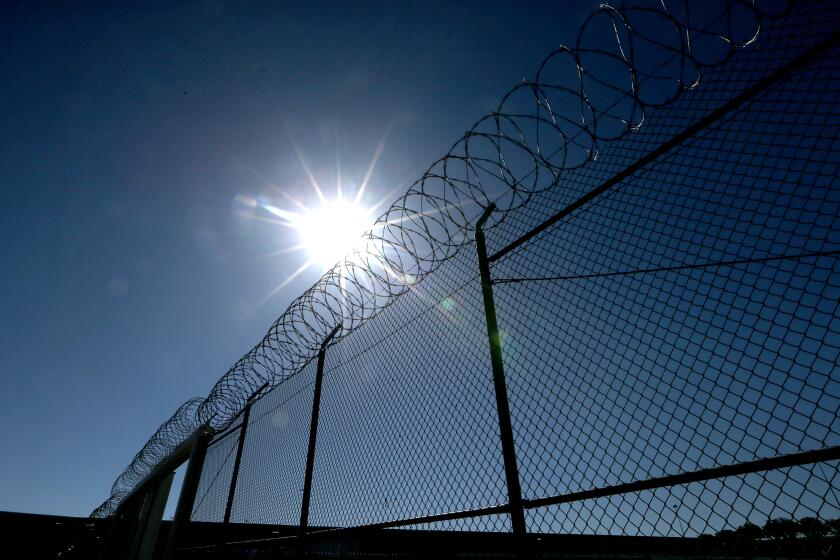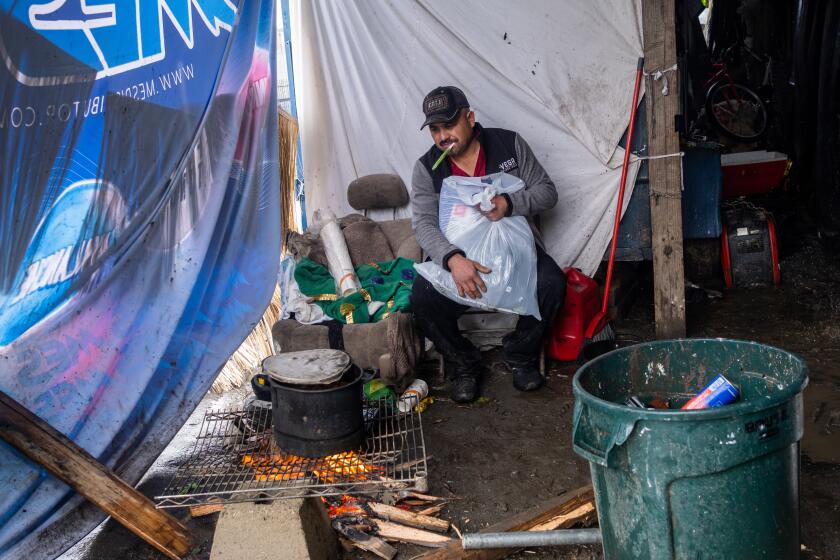LAPD Chemist Cites Errors but Defends Inquiry
A Los Angeles Police Department administrator painstakingly debated evidence collection with a lawyer for O.J. Simpson on Wednesday--a debate that yielded the chemist’s acknowledgment that the LAPD made some mistakes but that also produced his firm defense of the overall investigation.
Gregory Matheson, an assistant director and chief forensic chemist of the LAPD lab, was confronted with an array of topics by attorney Robert Blasier, who stared piercingly over the top of his reading glasses as he fired questions at the witness. Blasier’s subjects ranged from bloody test tubes to lab security to evidence tampering to the proper instrument for taking notes--pen or pencil.
Simpson’s lawyers maintain that sloppy evidence collection and testing has made much of the physical evidence in the case unreliable. They contend that their client, who has pleaded not guilty to the June 12 murders of Nicole Brown Simpson and Ronald Lyle Goldman, is the victim of a Police Department conspiracy to frame him for the crimes.
Although Blasier did not accuse Matheson of participating in any such conspiracy, he peppered his cross-examination with questions suggesting that conspirators could have orchestrated such a frame-up without Matheson’s knowledge. Matheson consistently rebuffed those suggestions without any display of anger or frustration.
Many other police witnesses have come under withering attack by the defense lawyers, but Matheson emerged from Wednesday’s session, his first full day of cross-examination, relatively unscathed. Unlike two less experienced criminalists whose testimony was sometimes undermined by their defensive demeanor, Matheson cheerfully but forcefully responded to each of Blasier’s arguments--even when the defense lawyer wrested admissions from him of less-than-perfect performances by lab workers.
In one typical exchange, Matheson acknowledged that some items of evidence were not booked until three days after they were collected from the crime scene and Simpson’s Rockingham Avenue estate. But even as he conceded that evidence should, under LAPD guidelines, be booked promptly, he rejected the defense theory that the delay offered the chance for tampering.
“It is longer than I would like to see it happen,” Matheson said in response to Blasier’s questions.
“And one of the reasons it’s longer than what you would like is because it’s in that . . . evidence processing room, which of the facilities we’ve talked about, is the least secure?” Blasier asked.
“No,” Matheson replied forcefully. “That is not one of the reasons.”
“That’s not any concern of yours at all?” Blasier asked incredulously.
“No, it isn’t,” the witness said. “Not as far as the security of the evidence goes. . . . Our business is evidence. There’s always evidence in that room.”
Although criminalists Dennis Fung and Andrea Mazzola were subjected to pointed, sometimes personal attacks, the defense altered its approach with Matheson, a far more experienced witness. Rather than attack him directly or accuse him of wrongdoing, Blasier tried to elicit Matheson’s admissions that his colleagues had made mistakes.
Matheson acknowledged that some steps were not perfect--he said that it would have been better to book some evidence more quickly and conceded that since the Simpson case unfolded, he has begun counting blood swatches to avoid questions about how many were collected. But the witness said none of those errors fundamentally compromised any evidence, testimony that he gave in cool, confident tones.
Bloody Socks
As previous defense lawyers have done, Blasier honed in on the collection and testing of a pair of socks that police discovered in Simpson’s bedroom.
Matheson testified Tuesday that blood on those socks was consistent with that of Nicole Simpson--and that it was not consistent with that of O.J. Simpson. Although Matheson has not testified about DNA tests later performed on bloodstains, other witnesses are expected to say that DNA analysis of the socks confirmed Matheson’s conventional tests that pointed to Nicole Simpson as the likely source of the blood.
That blood would be among the most difficult for the defense to explain because the Simpson team has not offered any explanation on how blood with genetic characteristics resembling one of the victims would end up on an item of Simpson’s clothing found in his bedroom.
In fact, defense attorneys have not challenged those results but have attacked the reliability of that evidence by suggesting that the socks were stained with blood after they were taken from Simpson’s house.
Attempting to reinforce that point Wednesday, Blasier asked when Matheson had first seen the socks. Matheson testified that it was during an evidence inventory on June 29, more than two weeks after the murders. Although Matheson said that he had inspected the socks then, he added that he did not notice blood on them--an oversight that he attributed to their dark color.
Under questioning from Blasier, Matheson acknowledged that it was two to three months after the socks were seized from Simpson’s bedroom that the blood was noticed. It was during that time, Simpson’s lawyers maintain, that the socks were tampered with--although the jury has yet to hear specific testimony on that point.
In addition to the opportunities for tampering with the socks, Blasier suggested that those items and other evidence could have been tainted while they were in a laboratory storage locker. Anyone with access to the lab could have gotten to the evidence, he suggested, bolstering that contention with flashy graphics and using them to build upon the defense conspiracy theory.
Matheson, however, said thousands of items are stored in the evidence control room, and he disputed Blasier’s suggestion that officers could have found the items even if they had succeeded in gaining access to the room.
“I would be very surprised if any of the officers in this case know how to operate our tracking computer,” he said.
Defending the Investigation
The alleged tainting of the socks and other evidence represents one element of the defense’s vigorous challenge to the credibility of physical evidence that prosecutors allege connects Simpson to the June 12 homicides. At the same time, however, the defense has contended that sloppy work by evidence collectors and analysts renders many of the samples unreliable.
The defense has most aggressively tried to make that point by cross-examining the two LAPD criminalists who gathered most of the physical evidence in the case, Mazzola and Fung.
Wednesday, Blasier continued that line of inquiry with Matheson, rattling off subject after subject where the defense maintains that aspects of the investigation were handled incorrectly. In some cases, Matheson agreed; most times, he did not.
Matheson disputed Blasier’s contention that proper evidence handling required changing gloves after touching every biological sample, though he acknowledged that he might have done just that when he was being observed by defense attorneys and experts during their tour of the police lab.
“We were being hypersensitive at that point to the handling of all these items,” Matheson admitted sheepishly.
The laboratory supervisor disputed the defense contention that every blood swatch collected from a crime scene need be counted. Again, however, Matheson admitted that defense questions on that subject had affected his behavior. Matheson said that while he had not previously counted swatches in his long LAPD career, he had begun doing so in recent months--if only to protect himself against the inquiries of defense lawyers who might use his failure to do so against him.
“I never used to count the number of swatches,” Matheson said. “Obviously, it became an issue in this case, and in the future, in an interest just to be able to answer that, I have tended to record it. But no, I don’t think it’s a vital issue.”
While defending most aspects of the investigation, Matheson did acknowledge that some aspects could have been handled better.
He said, for instance, that when a shirt belonging to Goldman was unwrapped from the packaging in which coroner’s officials had placed it, analysts were greeted with a strong, offensive odor. That signaled that it had been packaged while damp with blood, an improper technique that can spoil evidence for future testing.
Matheson acknowledged that test tubes containing the blood of the victims showed signs of poor handling. The defense displayed slides for the jury that revealed smeared blood on the outside of the test tubes, which were filled by the coroner’s office.
In his third day on the stand, Matheson agreed with the defense lawyer that it would have been better if LAPD criminalists had completed documenting the crime scene before the coroner had removed the two bodies and admitted that he was concerned that a detective had covered Nicole Simpson’s body with a blanket found inside her apartment.
There is no scientific justification for that step, Matheson testified. Detective Tom Lange, who made the decision to cover the victim’s body with the blanket, gave an unscientific reason for doing so when he was on the stand: Lange said he had done it out of respect for the victim and her family.
Matheson also disagreed with the technique that Mazzola used to test the inside of Simpson’s Ford Bronco for blood. Mazzola testified that she used a single swab to test the brake and gas pedals of the car, a procedure that Matheson said was unacceptable because of the possibility of contamination.
But he defended other areas that the defense questioned, including the suggestion that he or other supervisors compromised the investigation by failing to send a second team of criminalists to supplement Fung and Mazzola. Although Matheson said he offered assistance, Fung responded that he did not need it, and the supervisor said he agreed that the crime did not at first glance appear to warrant it.
“A double homicide,” Matheson said dryly, “is not an extremely rare occurrence in this city.”
Legal Battles
Wednesday is motions day in Judge Lance A. Ito’s court, and after sending the jury home for the afternoon, the judge tried to begin whittling away at the legal issues that have piled up in the face of his efforts to speed the trial along with more testimony each day.
One of those legal disputes is the effort by prosecutors to force Simpson’s longtime friend Robert Kardashian to take the witness stand to be questioned about his handling of one of Simpson’s bags on the day after the murders. Kardashian is a lawyer, and though his license was inactive at the time, he is objecting to the prosecution’s efforts to have him testify, saying that Simpson’s right to speak confidentially to his attorneys would be violated.
Janet Levine, a lawyer representing Kardashian on that issue, warned that the jury has seen Kardashian participate as a member of Simpson’s legal team and that calling him to the stand would unfairly invade the defense camp. Deputy Dist. Atty. Cheri Lewis countered that although eight defense attorneys have questioned witnesses in the case, Kardashian is not one of them.
Moreover, she said, Kardashian made himself an issue in the case when he carried off Simpson’s garment bag after Simpson returned to his estate from Chicago. The defense used a similar bag in cross-examining a prosecution witness, and it was then, Lewis said, that prosecutors decided to call Kardashian and ask him about the circumstances surrounding his handling of the bag.
Ito did not rule in the matter, instead asking the two sides to meet with Kardashian’s lawyers to see if they could find a way to introduce evidence about the bag without calling Kardashian to the stand. If they cannot do so--and Lewis expressed skepticism that they would, given Kardashian’s long friendship with Simpson--the matter could return to Ito for another hearing.
Putting that aside for now, Ito moved on to one of the most emotional disputes between the defense and prosecution in the case, the accusation by the Simpson team that Deputy Dist. Atty. Rockne Harmon is guilty of misconduct for allegedly trying to gather confidential information from experts hired by the defense.
Barry Scheck, one of Simpson’s DNA legal experts, accused Harmon of contacting a defense expert and trying to get information from him about tests performed on blood samples. “I think it’s wrong for prosecutors to be doing this,” Scheck said.
Harmon, who referred to the defense team as a “rogues’ gallery” trying to hide facts from the jury, retorted that he had done nothing wrong and was eager to clear his name. To do that, Harmon volunteered to testify about his actions if Ito decided that was necessary.
Instead, Ito asked the prosecutor to give him a declaration from an FBI agent familiar with some of the exchanges, and the judge said he would revisit the issue once he had read the declaration.
A third legal dispute--dueling requests for sanctions by the attorneys against one another--was put off until this afternoon. Ito is slated to consider it after testimony concludes for the day.
More to Read
Start your day right
Sign up for Essential California for news, features and recommendations from the L.A. Times and beyond in your inbox six days a week.
You may occasionally receive promotional content from the Los Angeles Times.







